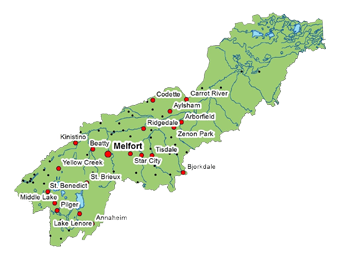Water Security Agency Forage Conversion Program
NAWMP_Target_Landscapes_SW_11x17
The Water Security Agency’s Forage Program Overview
The Water Security Agency’s (WSA) Forage Program is focused on a landowner’s conversion of annual cropland to perennial pasture. The landowner must sign an agreement with WSA to maintain the perennial pasture for a ten-year period. Seed costs are reimbursed up to $35 per acre.
It is important to note that invasive forage species are ineligible for WSA forage program. These species include: crested wheatgrass, smooth brome, timothy, kentucky blue grass, sweet clover, quack grass, and reed canary grass. Contact the Carrot River Valley Watershed Association (CRVWA) for details on eligible forage species or for application assistance.
Only land locations within the North American Waterfowl Management Plan landscapes are eligible: NAWMP_Target_Landscapes_SW_11x17. To check the eligibility of your land locations, contact the CRVWA (306-752-1270) or WSA (306-787-8577).
WSA Forage Program Environmental Benefits
Wetlands
The main goal of the WSA Forage Program is to help retain existing wetlands and provide upland nesting for waterfowl within the project area. Wetlands are very unique wildlife habitats with ample biodiversity and they are essential waterfowl nesting environments. Furthermore, wetlands provide beneficial services for people. Wetland plants are important in the natural filtration of water. Wetland plants are effective at utilizing excess nitrogen and phosphorus in the water so there is reduced water pollution downstream. Wetlands also help in flood protection and shoreline erosion control. They absorb water from rainstorms and snowmelt, and then release it slowly to provide streams and groundwater with a steady supply of fresh water. The spongy characteristic reduces the impacts of floods downstream and allows for a steady water supply for plants and animals (“Watersheds” Beck and Dobson, 1999).
Soil Health
Soil health is enhanced through conversion from annual crop production to perennial pastures. Soil and plants need each other to thrive. Soils are healthier when plants are continually covering them. As the health of the soil increases, so does the health of the plants growing from the soil. Soil health enhancement is vital to our province, as annual tilling, fertilizing, and harvesting continually degrade soil health. Specifically, perennial forages are directly responsible for a variety of improvements in the soil’s organic matter, structure, salinity, and fertility (Government of Manitoba, 2017).
Extensive root systems and reduced tillage help to build soil organic matter as microbes convert dead plant matter into plant nutrients. Soil organic matter is an essential piece to a healthy soil as it provides nutrients and habitat to the organisms in the soil. Soil organic matter also binds soil particles into aggregates that are responsible for an improvement of soil structure. A structured soil has a greater water holding capacity and is more resistant to crusting, compaction, droughts and erosion (Government of Manitoba, 2017).
Soil salinity can be managed through the use of forages as they provide cover to help reduce evaporation, thereby reducing the capillary rise of salts in the soil profile. Deep-rooted perennial forages can also lower the existing groundwater level, which allows salts to flush downward in the soil profile (Government of Alberta, 2007).
Certain forages increase soil fertility. Inoculated legume forages fix nitrogen from the air and make it available for plant growth and development. The nitrogen stored by the legume is then returned to the soil through root decay, thus increasing the fertility of the soil and reducing greenhouse gases. The increase of soil fertility using legumes reduces the need of artificial fertilizer and fertilizer runoff.
Contact Brady Myhr at (306) 752-1270 or (306) 920-7069 for more information.

